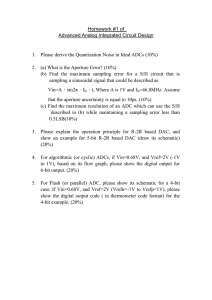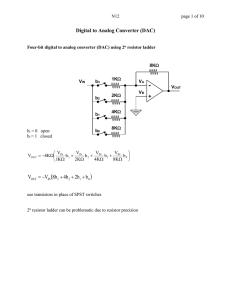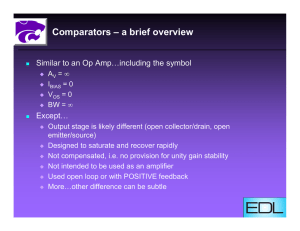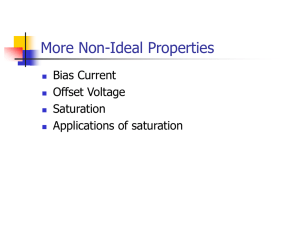Designing Gain and Offset in Thirty Seconds
advertisement
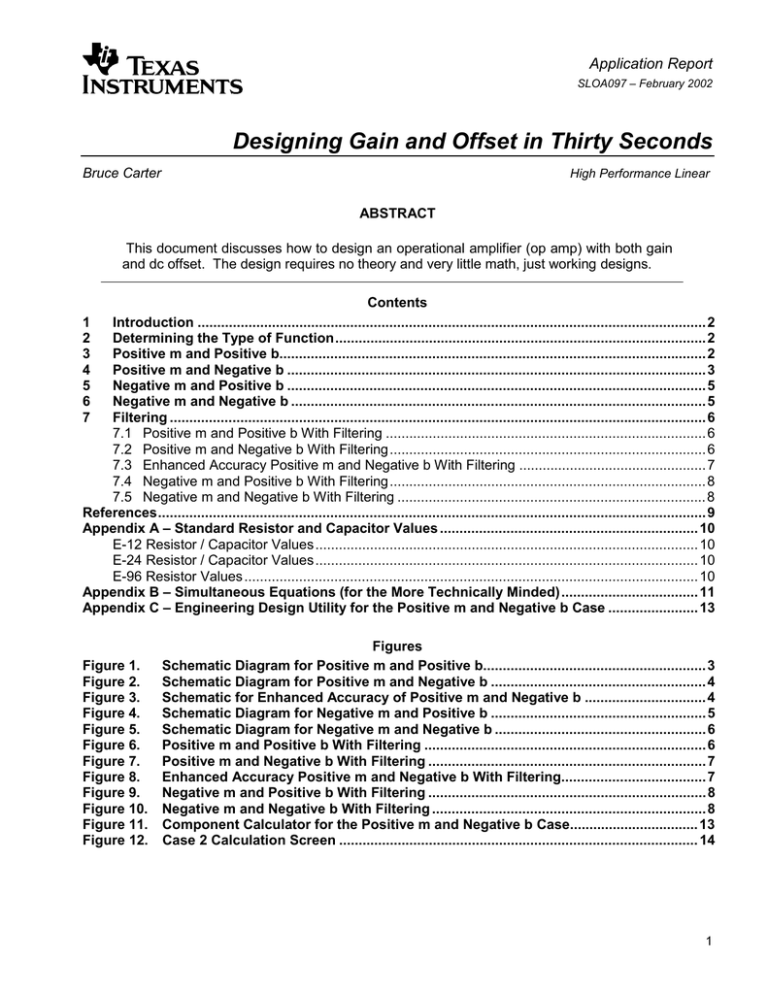
Application Report SLOA097 – February 2002 Designing Gain and Offset in Thirty Seconds Bruce Carter High Performance Linear ABSTRACT This document discusses how to design an operational amplifier (op amp) with both gain and dc offset. The design requires no theory and very little math, just working designs. Contents 1 Introduction .................................................................................................................................. 2 2 Determining the Type of Function............................................................................................... 2 3 Positive m and Positive b............................................................................................................. 2 4 Positive m and Negative b ........................................................................................................... 3 5 Negative m and Positive b ........................................................................................................... 5 6 Negative m and Negative b .......................................................................................................... 5 7 Filtering ......................................................................................................................................... 6 7.1 Positive m and Positive b With Filtering .................................................................................. 6 7.2 Positive m and Negative b With Filtering................................................................................. 6 7.3 Enhanced Accuracy Positive m and Negative b With Filtering ................................................ 7 7.4 Negative m and Positive b With Filtering................................................................................. 8 7.5 Negative m and Negative b With Filtering ............................................................................... 8 References............................................................................................................................................ 9 Appendix A – Standard Resistor and Capacitor Values .................................................................. 10 E-12 Resistor / Capacitor Values.................................................................................................. 10 E-24 Resistor / Capacitor Values.................................................................................................. 10 E-96 Resistor Values .................................................................................................................... 10 Appendix B – Simultaneous Equations (for the More Technically Minded) ................................... 11 Appendix C – Engineering Design Utility for the Positive m and Negative b Case ....................... 13 Figures Figure 1. Schematic Diagram for Positive m and Positive b......................................................... 3 Figure 2. Schematic Diagram for Positive m and Negative b ....................................................... 4 Figure 3. Schematic for Enhanced Accuracy of Positive m and Negative b ............................... 4 Figure 4. Schematic Diagram for Negative m and Positive b ....................................................... 5 Figure 5. Schematic Diagram for Negative m and Negative b ...................................................... 6 Figure 6. Positive m and Positive b With Filtering ........................................................................ 6 Figure 7. Positive m and Negative b With Filtering ....................................................................... 7 Figure 8. Enhanced Accuracy Positive m and Negative b With Filtering..................................... 7 Figure 9. Negative m and Positive b With Filtering ....................................................................... 8 Figure 10. Negative m and Negative b With Filtering ...................................................................... 8 Figure 11. Component Calculator for the Positive m and Negative b Case................................. 13 Figure 12. Case 2 Calculation Screen ............................................................................................ 14 1 SLOA097 1 Introduction This document is intended for designers that have an input source with a voltage range and dc offset that are incompatible with the load, which must be referenced to a different dc offset and requires a different voltage range. To design such a circuit, some things must be known in advance: • The voltage level of a stable reference, Vref = _____ • The full-scale output voltage, Voutfs = _____ • The zero-scale output voltage, Voutzs = _____ • The full-scale input voltage, Vinfs = _____ • The zero-scale input voltage, Vinzs = _____ There is a companion Engineering Design Utility for this application note, available in the Engineer Design Utilities in the Amplifiers and Comparators section of the Analog and Mixed Signal link from the Texas Instruments web page. Appendix C describes this utility. Designing the gain and offset stage 2 Determining the Type of Function Determining the type of function depends on the sign of two numbers: m (the gain of the stage) and b (the offset of the stage) – that are calculated now. 3 Vout fs − Vout zs = _____ Vin fs − Vin zs • Calculate m = • Calculate b = Vout zs − m × Vin zs = _____ • Go to the section determined by the sign of the numbers m and b – Positive m and positive b – go to Section 3 – Positive m and negative b – go to Section 4 – Negative m and positive b – go to Section 5 – Negative m and negative b – go to Section 6 Positive m and Positive b To determine positive m and positive b; 2 • Choose R1 = _____ • Calculate R 2 = • Select Rf (may be suggested by data sheet) = _____ Vref × R1 × m = _____ b Designing Gain and Offset in Thirty Seconds SLOA097 • Calculate Rg = R2 × Rf = _____ m × (R1 + R2 ) − R2 R1 + Vin Vout R2 Rf Vref Rg Figure 1. Schematic Diagram for Positive m and Positive b Refer to Section 7 4 Positive m and Negative b Determining positive m and negative b may take a little longer. NOTE: The following is an approximation, which assumes R1 >> Rg2 • Choose Rf (may be suggested on data sheet). Rf = ______ • Calculate Rg = Rf =_____ m −1 • Choose Rg2 ≈ Rg = ______ 10 • Calculate Rg1 = Rg – Rg2 = _____ • Calculate Vref ' = • Calculate R1 = b × Rg1 Rg1 + Rf = _____ Rg2(Vref − Vref ') = _____ Vref ' Designing Gain and Offset in Thirty Seconds 3 SLOA097 Vref R1 Vref' Rg1 Rf Rg2 - Vout + Vin Figure 2. Schematic Diagram for Positive m and Negative b Tuning This is the point at which the approximation accumulates errors. It may be necessary to tweak the value of R1 a bit to compensate for errors that the approximation yields. If more accuracy is required, it is necessary to eliminate the interaction of gain resistors. There are two ways to proceed if a more accurate answer is required. Use the companion Engineering Design Utility for this application note, available in the Engineer Design Utilities in the Amplifiers and Comparators section of the Analog an Mixed Signal link from the Texas Instruments web page. Appendix C describes this utility. The second way to achieve more accuracy is by adding a second op amp: Vref R1 + Vref' Rg Rf R2 + Vout Vin Figure 3. Schematic for Enhanced Accuracy of Positive m and Negative b To use the enhanced accuracy schematic: 4 • Select Rf (may be suggested on data sheet) = _____ • Calculate Rg = Rf = _____ m −1 Designing Gain and Offset in Thirty Seconds SLOA097 b • Calculate Vref ' = • Select R1 = _____ • Calculate R 2 = m = _____ Vref '×R1 = _____ Vref − Vref ' When you are finished with the enhanced accuracy schematic, go to Section 7 5 Negative m and Positive b Selecting negative value for m and positive value for b; • Choose Rf (may be suggested on data sheet). Rf = ______ • Calculate Rg = • Choose R2 (same order of magnitude as Rf). R2 = _____ • Calculate R1 = Rf = _____ m b × R2 × Rg = _____ Vref × (Rf + Rg) − b × Rg Rg Rf Vin - R2 Vout + Vref R1 Figure 4. Schematic Diagram for Negative m and Positive b Refer to Section 7 6 Negative m and Negative b Selecting negative value for m and positive value for b; • Choose Rf (may be suggested on data sheet). Rf = ______ • Calculate Rg1 = Rf = _____ m Designing Gain and Offset in Thirty Seconds 5 SLOA097 Calculate Rg2 = Vref × • Rf = _____ b Rg1 Rf Vin Rg2 Vref - Vout + Figure 5. 7 Schematic Diagram for Negative m and Negative b Filtering Simultaneous gain, offset, and filtering in one op amp are possible. Find the case below. 7.1 Positive m and Positive b With Filtering Given a rolloff frequency fo, the value of Co can be determined by: Co = 1 = _____ 2 × π × R1 × fo R1 Vin + Vref Figure 6. Co Rg - R2 Vout Rf Positive m and Positive b With Filtering NOTE: The reference voltage will also be rolled off at a frequency determined by: fo = 7.2 1 = _____ 2 × π × R2 × C o Positive m and Negative b With Filtering Given a rolloff frequency fo: • 6 Select a value for Ro = _____ Designing Gain and Offset in Thirty Seconds SLOA097 • 1 = _____ 2 × π × Ro × fo Calculate Co = Vref R1 Rg1 Vref' Rf Rg2 - Vout + Ro Vin Co Figure 7. Enhanced Accuracy Positive m and Negative b With Filtering Given a rolloff frequency fo: • Select a value for Ro = _____ • Calculate Co = 1 = _____ 2 × π × Ro × fo Vref R1 R2 Rg Rf - Vref' + 7.3 Positive m and Negative b With Filtering + Ro Vout Vin Co Figure 8. Enhanced Accuracy Positive m and Negative b With Filtering Designing Gain and Offset in Thirty Seconds 7 SLOA097 7.4 Negative m and Positive b With Filtering Given a rolloff frequency fo, the value of Cf can be determined by: Cf = 1 = _____ 2 × π × Rf × fo Cf Rg Rf Vin - R2 + Vref Vout R1 Figure 9. 7.5 Negative m and Positive b With Filtering Negative m and Negative b With Filtering Given a rolloff frequency fo, the value of Cf can be determined by: Cf = 1 = _____ 2 × π × Rf × fo Cf Rg1 Rf Vin Rg2 Vref + Vout Figure 10. Negative m and Negative b With Filtering 8 Designing Gain and Offset in Thirty Seconds SLOA097 References 1. Chapter 4 - Single-Supply Op Amp Design Techniques, Texas Instruments SLOA076 09/14/2001 Designing Gain and Offset in Thirty Seconds 9 SLOA097 Appendix A – Standard Resistor and Capacitor Values E-12 Resistor / Capacitor Values 1.0, 1.2, 1.5, 1.8, 2.2, 2.7, 3.3, 3.9, 4.7, 5.6, 6.8, and 8.2; multiplied by the decade value. E-24 Resistor / Capacitor Values 1.0, 1.1, 1.2, 1.3, 1.5, 1.6, 1.8, 2.0, 2.2, 2.4, 2.7, 3.0, 3.3, 3.6, 3.9, 4.3, 4.7, 5.1, 5.6, 6.2, 6.8, 7.5, 8.2, and 9.1; multiplied by the decade value. E-96 Resistor Values 1.00, 1.02, 1.05, 1.07, 1.10, 1.13, 1.15, 1.18, 1.21, 1.24, 1.27, 1.30, 1.33, 1.37, 1.40, 1.43, 1.47, 1.50, 1.54, 1.58, 1.62, 1.65, 1.69, 1.74, 1.78, 1.82, 1.87, 1.91, 1.96, 2.00, 2.05, 2.10, 2.15, 2.21, 2.26, 2.32, 2.37, 2.43, 2.49, 2.55, 2.61, 2.67, 2.74, 2.80, 2.87, 2.94, 3.01, 3.09, 3.16, 3,24, 3.32, 3.40, 3,48, 3.57, 3.65, 3.74, 3.83, 3.92, 4.02, 4.12, 4.22, 4,32, 4.42, 4,53, 4.64, 4.75, 4.87, 4.99, 5.11, 5.23, 5.36, 5.49, 5.62, 5.76, 5.90, 6.04, 6.19, 6.34, 6.49, 6.65, 6.81, 6.98, 7.15, 7.32, 7.50, 7.68, 7.87, 8.06, 8.25, 8.45, 8.66, 8.87, 9.09, 9.31, 9.53, 9.76; multiplied by the decade value. 10 Designing Gain and Offset in Thirty Seconds SLOA097 Appendix B – Simultaneous Equations (for the More Technically Minded) A linear op amp transfer function is described by the equation of a straight line (Equation 1). y = ±mx ± b (1) where m is the slope of the line, and b is the intercept of the line The equation of a straight line has four possible solutions depending upon the sign of m and b; thus simultaneous equations yield solutions in four forms. Four circuits must be developed; one for each form of the equation of a straight line. The four equations are given in Equations 2 through 5. y = +mx + b (2) y = +mx − b (3) y = −mx + b (4) y = −mx − b (5) The sign of m and b determines the type of circuit required to implement the solution. The designer can easily determine the value and sign of m by the following equation: m= Vout fs − Vout zs Vin fs − Vin zs (6) Where: Voutfs is the full-scale output voltage Voutzs is the zero-scale output voltage Vinfs is the full-scale input voltage Vinzs is the zero-scale input voltage Consider the example of a sensor with an output signal ranging from 0.1 to 0.2 Vdc, being required to interface to an analog to digital converter with an input range of 1 to 4 Vdc. Vinzs = 0.1 Vdc (7) Vinfs = 0.2 Vdc (8) Voutzs = 1 Vdc (9) Voutfs = 4 Vdc (10) Therefore: Designing Gain and Offset in Thirty Seconds 11 SLOA097 m= 4 −1 3 = = 30 0. 2 − 0. 1 0 . 1 (11) This limits the transfer function for the op amp to either equation 2 or 3 – the ones with positive values of m. The value and sign of b can be determined by plugging the value of m into equation 2. If the guess about the sign of b is wrong, the math is self-correcting and the correct sign will be revealed. 1 = 30 * 0.1 + b (12) 1–3=b (13) b = -2 (14) The correct form of the equation of the example straight line is therefore: y = +mx − b 12 Designing Gain and Offset in Thirty Seconds (15) SLOA097 Appendix C – Engineering Design Utility for the Positive m and Negative b Case Figure 11 shows a screen capture of the case selection page of the utility, which is implemented as a Microsoft Excel® Spreadsheet. Figure 11. Component Calculator for the Positive m and Negative b Case The utility is pre-loaded with examples from Section 4.3 of Op Amps for Everyone. Chapter 4 is also available as a stand-alone application note (reference 1). The way the designer uses this utility: • Enter the 5 values called for in the yellow boxes of the case selection page of the utility; Vinzs, Vinfs, Voutzs, Voutfs, and Vref. • Go to the case indicated by the prompt on the case selection page. When the designer goes to the appropriate case, they will be prompted for one or more “seed“ values of resistor. Figure 12 shows one of the four cases: Designing Gain and Offset in Thirty Seconds 13 SLOA097 Figure 12. Case 2 Calculation Screen Data entry is done in two columns, in this case the field for Rf is shown in yellow in the left column, and is the only column required to generate the other three resistor values. Data entry is made from a drop-down list, which has the 5% resistor sequence followed by the 1% resistor sequence. When the seed resistor value is selected from the drop-down list in the left column, the designer then selects the other resistors in the right hand column – also from drop-down lists, finding the standard value closest to the calculated value. In case 2, shown here, the offset is slightly off with the calculated values (the algorithm is an approximation). The offset can be adjusted with very little interaction on the gain “m” by varying R1. When it is reduced to 18 kΩ, the offset is very close to ideal. The resulting “real world” values calculated for m, b, Voutzs, and Voutfs are shown to the right of the resistor selection boxes, and a graph is shown underneath of the transfer function for the line. 14 Designing Gain and Offset in Thirty Seconds IMPORTANT NOTICE Texas Instruments Incorporated and its subsidiaries (TI) reserve the right to make corrections, modifications, enhancements, improvements, and other changes to its products and services at any time and to discontinue any product or service without notice. Customers should obtain the latest relevant information before placing orders and should verify that such information is current and complete. All products are sold subject to TI’s terms and conditions of sale supplied at the time of order acknowledgment. TI warrants performance of its hardware products to the specifications applicable at the time of sale in accordance with TI’s standard warranty. Testing and other quality control techniques are used to the extent TI deems necessary to support this warranty. Except where mandated by government requirements, testing of all parameters of each product is not necessarily performed. TI assumes no liability for applications assistance or customer product design. Customers are responsible for their products and applications using TI components. To minimize the risks associated with customer products and applications, customers should provide adequate design and operating safeguards. TI does not warrant or represent that any license, either express or implied, is granted under any TI patent right, copyright, mask work right, or other TI intellectual property right relating to any combination, machine, or process in which TI products or services are used. Information published by TI regarding third–party products or services does not constitute a license from TI to use such products or services or a warranty or endorsement thereof. Use of such information may require a license from a third party under the patents or other intellectual property of the third party, or a license from TI under the patents or other intellectual property of TI. Reproduction of information in TI data books or data sheets is permissible only if reproduction is without alteration and is accompanied by all associated warranties, conditions, limitations, and notices. Reproduction of this information with alteration is an unfair and deceptive business practice. TI is not responsible or liable for such altered documentation. Resale of TI products or services with statements different from or beyond the parameters stated by TI for that product or service voids all express and any implied warranties for the associated TI product or service and is an unfair and deceptive business practice. TI is not responsible or liable for any such statements. Mailing Address: Texas Instruments Post Office Box 655303 Dallas, Texas 75265 Copyright 2002, Texas Instruments Incorporated
